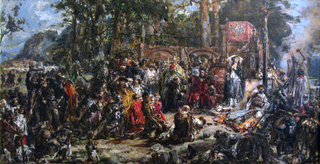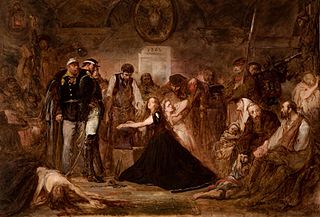 W
WAstronomer Copernicus, or Conversations with God is an oil painting by the Polish artist Jan Matejko, finished in 1873, depicting Nicolaus Copernicus observing the heavens from a balcony by a tower near the cathedral in Frombork. Currently the painting is in the collection of the Jagiellonian University of Kraków, which purchased it from a private owner with money donated by the Polish public.
 W
WThe Baptism of Lithuania is an 1888 oil on canvas painting by the Polish artist Jan Matejko, showing the conversion of Lithuania to Christianity and the baptism of the Boyar princes and people before the temple of the pagan god Perkunas on Holy Saturday 1387. It forms part of the artist's series The History of Civilisation in Poland.
 W
WThe Battle of Grunwald is a painting by Jan Matejko depicting the Battle of Grunwald and the victory of the allied Crown of the Kingdom of Poland and Grand Duchy of Lithuania over the Teutonic Order in 1410. The canvas dates to 1878 and is one of the most heroic representations of the history of Poland and Lithuania. It is displayed in the National Museum in Warsaw.
 W
WThe Constitution of 3 May 1791 is an 1891 Romantic oil painting on canvas by the Polish artist Jan Matejko. It is a large piece, and one of Matejko's best known. It memorializes the Polish Constitution of 3 May 1791, a milestone in the history of the Polish–Lithuanian Commonwealth and a high point of the Polish Enlightenment.
 W
WHistory of Civilization in Poland is a cycle of twelve oil sketches on canvas and wood, created by the Polish nominal painter Jan Matejko in 1889 with accompanying commentaries. The originals are kept at the Museum of the Royal Castle, Warsaw.
 W
WPoland – The Year 1863 or The Forging of Poland is an early and unfinished oil on canvas painting by Jan Matejko, painted in 1864 in response to his experiences during the January Uprising and now in the Czartoryski Museum in Krakow.
 W
WThe Prussian Homage is an oil on canvas painting by Polish painter Jan Matejko painted between 1879 and 1882 in Kraków. The painting depicts the "Prussian Homage," a significant political event from the time of the Renaissance in Poland in which Albrecht Hohenzollern, the Duke of Prussia paid tribute and swore allegiance to King Sigismund I the Old in Kraków's market square on 10 April 1525. Matejko depicted over thirty important figures of the Polish Renaissance period, taking the liberty of including several who were not actually present at the event.
 W
WRejtan, or the Fall of Poland is an oil painting by the Polish artist Jan Matejko, finished in 1866, depicting the protest of Tadeusz Rejtan against the First Partition of Poland during the Partition Sejm of 1773. Both a depiction of a historical moment, and an allegory for the surrounding period of Polish history, the painting is one of Matejko's most famous works, and an iconic picture of an emotional protest.
 W
WThe Sermon of Piotr Skarga or Skarga's Sermon is a large oil painting by Jan Matejko, finished in 1864, now in the National Museum, Warsaw in Poland. It depicts a sermon on political matters by the Jesuit priest Piotr Skarga, a chief figure of the Counter Reformation in Poland, where he rebukes the Polish elite for neglecting the national interest.
 W
WStephen Báthory at Pskov or Báthory at Pskov is a partially allegorical historical painting 1872 by the Polish artist Jan Matejko, now in the collections of the Royal Castle in Warsaw, Poland. It shows people of the Russian tsar Ivan the Terrible kneeling before the Polish king Stephen Báthory at Pskov during the final period of peace negotiations at the end of the 1578-1582 Livonian campaign. It also shows the papal legate, the black-robed Jesuit Antonio Possevino.
 W
WUnion of Lublin is an oil painting by the Polish artist Jan Matejko, finished in 1869, depicting the Union of Lublin. It is owned by the National Museum, Warsaw. and displayed at Lublin Museum.
 W
WZawieszenie dzwonu Zygmunta is a painting by Jan Matejko finished in 1874. It depicts the installation of the Sigismund Bell in the Wawel Cathedral in Kraków in 1521. The bell was installed in the Sigismund Tower and rung for the first time on 13 July 1521. The bell is considered to be one of the national symbols of Poland. This painting is one of a number of historical paintings by Matejko. It shows a crowd of people, with a number of identifiable figures of historical importance. It conveys the Golden Era of the Polish Renaissance, and the power of the Kingdom of Poland.